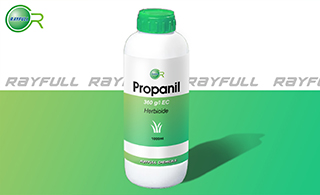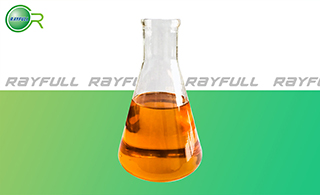Propanil
  өР°Ю өР°Ю
Introduction: Propanil is an acetanilide post-emergence herbicide with no residual effect. It is used against numerous grasses and broad-leaved weeds in rice, potatoes, and wheat. It is available as emulsifiable concentrates, liquid and dry flowable, low volume, and ultra low volume (ULV) formulations. Mixing with carbamates or organophosphorans compounds is not recommended. The information presented here, unless otherwise noted, pertains to technical propanil.
Common name: Propanil
Another name: Propanide; N-(3,4-Dichlorophenyl)propanamide; Grascide; Propanex; Propanid; Supernox; Surcopur; Dipram; Rogue; STAM; Montrose propanil; Chem Rice; etc.
Chemical name: 3',4'-dichloropropionanilide
Empirical formula: C9H9Cl2NO
Structural formula:

Mol. Weight: 218.08 g/mol
CAS No.: 709-98-8
Specifications
Leading Propanil supplier
Propanil 97% TC
Propanil 360 g/L EC
Packing:
BULK PACKING
Powder: 25kg/Bag, 25kg/Drum, 50kg/Drum etc.
Liquid: 200L/Drum, 20L/Drum, 10L/Drum etc.
SMALL PACKING
Powder: 1kg/Alu bag, 500g/Alu bag, 200g/Alu bag, 100g/Alu bag, 50g/Alu bag, 15g/Alu bag etc.
Liquid: 5L/Drum, 1L/Bottle, 500ml/Bottle, 250ml/Bottle, 100ml/Bottle, 50ml/Bottle etc.
Customerized packing label
Propanil FAO standard
Professional registration
HAZARDS IDENTIFICATION
Hazard statement(s)
H302 (100%): Harmful if swallowed.
H332 (28.3%): Harmful if inhaled.
H400 (100%): Very toxic to aquatic life.
Precautionary statement(s)
P261: Do not breathe dust/fume/gas/mist/vapors/spray.
P264: Wash ... thoroughly after handling.
P270: Do not eat, drink or smoke when using this product.
P271: Use only outdoors or in a well-ventilated area.
P273: Avoid release to the environment.
P301+P312:
P304+P312: IF INHALED: Call a POISON CENTER/doctor/... if you feel unwell.
P304+P340: IF INHALED: Remove person to fresh air and keep comfortable for breathing.
P312: Call a POISON CENTER or doctor/... if you feel unwell.
P330: Rinse mouth.
P391: Collect spillage.
P501: Dispose of contents/container to an approved waste disposal plant.
Supplemental Hazard Statements: none.
MAMMALIAN TOXICOLOGY
Acute toxicity: 1) Acute oral LD50 for rats is 960 a.i.mg/kg. 2) Acute dermal LD50 for rats is >2000 a.i.mg/kg. 3) Acute inhalation toxicity LC50 (4 h) for rats is 1.25 a.i.mg/L. 4) Skin irritation: Non-irritating to skin (rabbits). 5) Eye irritation: Non-irritating to eyes (rabbits). 6) Skin sensitization for guinea pig: Not a skin sensitiser.
NOEL: (2 y) for rats is 19 mg/kg/day; (2 y) for dogs is 12.6 mg/kg/day. Other Not carcinogenic. No evidence of teratogenic effects was observed in studies with rats and mice.
ADI 0-0.02 mg/kg b.w.
Classification:
WHO Classification: II (Moderately hazardous)
EC Risk Classification: Xn - Harmful: R22; N - Dangerous for the environment: R50
US EPA Classification (formulation): III (Caution - Slightly toxic )
ECOTOXICOLOGY
Effect on birds: Acute oral LD50 for Bobwhite quail is 196 a.i.mg/kg. Effect on fish: Acute LC50 (96 h) for Rainbow trout is 5.4 a.i.mg/l. Effects on aquatic invertebrates: Acute EC50 (48 h) for Daphnia magna is 2.39 a.i.mg/l. Effects on algae: Acute 72 hour EC50 for Selenastrum capricornutum is 0.11 a.i.mg/l. Effects on bees: contact acute 48 hour LD50 is >100 a.i.ҰМg/bee, oral acute 48 hour LD50 is >94.3 a.i.ҰМg/bee. Effects on earthworms: Acute 14 day LC50 is 734 a.i.mg/kg.
ENVIRONMENTAL FATE
Animals The major metabolic pathway for propanil in microsomal incubations was acylamidase hydrolysis to 3,4-dichloroaniline (D. C. McMillan et al., Tox. Appl. Toxicol., 1990, 103, 90). Plants In rice, propanil is hydrolysed by an aryl acylamidase to 3,4-dichloroaniline and propionic acid as metabolic intermediates. Soil/Environment In soil, rapid microbial degradation to the aniline derivative occurs. Duration of activity in warm, moist conditions is only a few days. Degradation products are propionate which is rapidly metabolised to CO2, and 3,4-dichloroaniline which is bound (80% in 27 h) to the soil. Koc 239-800.
Usage: Propanil was introduced by Rohm & Haas Co. (now Dow AgroSciences). Propanil is a post-emergence herbicide used for broad-leaved and annual grass weed control in rice and other crops.
Application: Biochemistry Photosynthetic electron transport inhibitor at the photosystem II receptor site. Mode of action Selective contact herbicide with a short duration of activity. Uses Contact herbicide used post-emergence in rice, at 2.5-5.0 kg/ha, to control broad-leaved and grass weeds, including Amaranthus retroflexus,Digitaria spp., Echinochloa spp., Panicum spp., and Setaria spp. Also used, in mixture with MCPA, in wheat. A mixture with carbaryl is used in citrus crops grown in sod culture. Phytotoxicity Phytotoxic to many broad-leaved crops. Normally phytotoxic to crops which have been treated with organophosphate or carbamate insecticides.
| 






